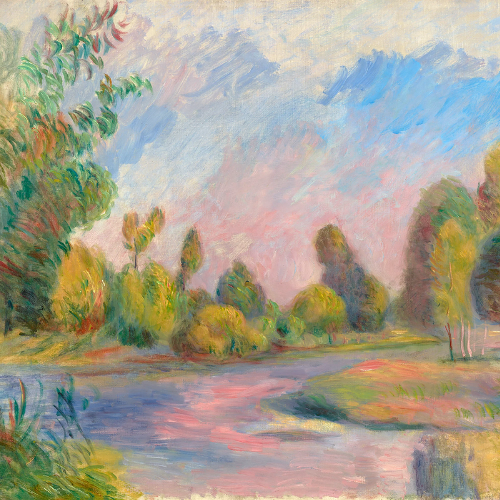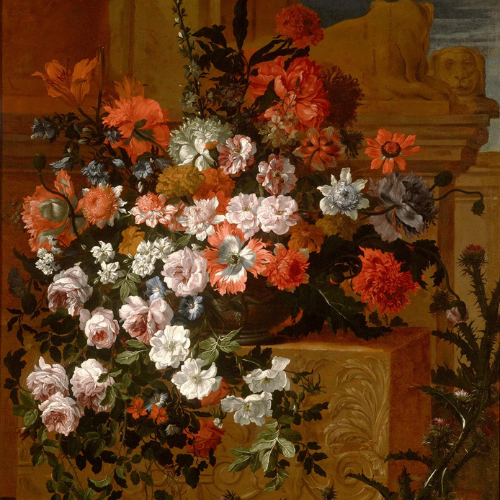The depiction of animals in an artwork is as old as humanity itself. Some of the earliest representations are those found in the cave paintings of our ancestors, particularly about to hunting and daily interaction with wildlife. But as civilization evolved, so too did our relationship with the animal kingdom. No longer were animals strictly a source of sustenance, but rather famous muses. They came to represent ancient gods and goddesses (Bastet, the Egyptian cat goddess of war), spiritual qualities (the Bear, a spirit animal of courage and strength to Native Americans) and status symbols (the high-status symbol of the Elephant to Roman culture).
These early animal representations were soon pushed aside in favor of the prevalent stylistic movements (Romanticism, Academic, Neoclassicism) and more “important” fine and rare art genres (Historical, Portraiture, Religious) that became paramount in the artistic landscape from the Medieval through the 17th century. However, even at this stage, artists often collaborated with specialized animal painters, known collectively today as “animaliers” or “wildlife artists” who specialize in animal paintings. For example, while the main artist would compose the primary subject, for instance, a portrait, the animal artist would come in and paint the sitter’s favorite dog.
By the end of the 17th century, animal artists truly came into their own, especially in British art. As people began emphasizing the companionship and personal relationships they shared with their beloved pets, the demand for high-quality animal art skyrocketed, particularly amongst the wealthy and nobility.
Let’s take a look at 5 of the most renowned British animal painters and how their animal artwork left an indelible mark upon our adoration and appreciation for all creatures, big and small.
George Stubbs, 1724-1806
George Stubbs is considered a true artistic genius, and a favorite of the aristocracy for his horse paintings. Renowned for the subtlety and precision of his technique, the artist was equally at home painting elegant landscapes as he was his four-legged subjects, as he often depicted animals in their natural surroundings, such as seen in Portrait of a Gentleman upon a Grey Hunter. Remarkably, he was largely self-taught. He acquired his knowledge of composition after extensive travels throughout Italy, where he studied the great Renaissance masters.

Portrait of a Gentleman on a Grey Hunter by George Stubbs. Signed and dated "Geo.Stubbs pinxit/1781" (lower right). Oil on panel.
Stubbs’ quest for realism led him to conduct his own anatomical studies of the horse, and his incredible exactitude and understanding of equine anatomy have yet to be equaled. The British painter’s careful observation and studies led to his 1766 book, The Anatomy of the Horse. Yet, his creatures are more than anatomically exact - Stubbs' captured the expressiveness of his equine subjects with equal aptitude. Perhaps his most renowned work that showcases his unparalleled talent is Whistlejacket, a work he created for the 2nd Marquess of Rockingham that now resides in the National Gallery in London. The proportions, musculature and overall detailing are second to none, making it clear why Stubbs’s works continue to enthrall all who view them.
John Frederick Herring, Sr., 1795-1865
John Frederick Herring Sr. is considered one of the most masterful animal painters of the 19th century. The British painter was the son of a London merchant of Dutch parentage who was born in America. The first 18 years of his life were spent in London, where his greatest interests were drawing and horses. In 1814, he moved to Doncaster, arriving just in time to see the Duke of Hamilton's William win the St. Leger Stakes, the oldest of Britain's Five Classics that is still run today. In Doncaster, Herring first earned his living painting coach insignia and inn signs while also working as a night coach driver. His spare time was spent painting portraits of horses for inn parlors and he became known as the 'artist coachman.' Herring's talent was quickly recognized, and he soon found himself painting hunters and racehorses for the gentry. From that point, he enjoyed a meteoric rise to artistic success, with his sons John Frederick, Jr., Charles and Benjamin eventually becoming artists and his daughters Ann and Emma both marrying painters.
In 1833, Herring moved to London, where he suffered financial difficulties until being rescued by W. T. Copeland, who commissioned many paintings, including designs used for Copeland Spode bone china. In 1840-41, Herring visited Paris by invitation of the Duc d'Orleans (who had heard of Herring's skill by one of his admirers, the famed Romanticist Theodore Gericault), for whom he painted several pictures. In 1845, Herring was appointed Animal Painter to HRH the Duchess of Kent, followed by a commission from Queen Victoria, who was to remain a patron for the rest of his life.

A Grey Horse with a Goat, a Toy Spaniel and a Cat by John Frederick Herring, Sr. Signed and dated "J.F.Herring Sen. 1847" (lower left). Oil on canvas.
Though known primarily for his horses, Herring was adept at rendering various animals, whom he often depicted interacting with his equine subjects. In A Grey Horse with a Goat, a Toy Spaniel and a Cat, Herring depicts his beloved Arabian Stallion, Imaum (originally a gift from the Imaum of Muscat to Queen Victoria), in a stable scene along with the comparatively diminutive inhabitants of his horse barn. Herring places on full display the sheer size and power of Imaum while simultaneously demonstrating his genteel nature.
Sir Edwin Henry Landseer, 1802-1873
Considered by many the greatest animal painter of all time, Landseer’s immense talent emerged at a young age. The son of the engraver John Landseer A.R.A., Sir Edwin Landseer was considered a child prodigy, and he showcased his first original painting at the Royal Academy in 1815 at the age of just 13. His reputation as an animal painter was unrivaled in his age, and his brother, Thomas Landseer, reproduced many of his works as engravings.This practice earned them both considerable income and allowed them to create paintings that tell a story.
He possessed a remarkable talent for capturing the personality and mystique of animals, which appealed to the English taste, and later to Queen Victoria herself. The Queen granted him numerous commissions for portraits of the royal pets. Landseer would produce over 40 works for Queen Victoria and Prince Albert during his career, the great majority of which are still held at Buckingham Palace. While many of these works solely capture the Queen’s large menagerie, some also include the royal couple, such as his famed Windsor Castle in Modern Times in the Royal Trust Collection. Yet, animals were the subject for which he was most celebrated.

Portrait of an Arab Mare with her Foal by Sir Edwin Henry Landseer.
Signed with initials and dated "1825". Oil on canvas.
John Emms, 1844-1912
Born in Norfolk in 1844, John Emms was the son of the amateur artist Henry William Emms. He moved to London at an early age and became assistant to the famed Frederic Lord Leighton. Leighton was the first painter to receive a peerage, and through him, Emms gained access into the inner circles of the British elite. He became an avid hunter, and his presence on the field gained him no shortage of new commissions throughout his career.He made his debut at the Royal Academy in 1866 and thereafter exhibited throughout England. A flamboyant figure, Emms enjoyed remarkable success during his lifetime until a stroke in the early 1900s made it impossible for him to continue painting. However, this portrait, entitled Anticipation, shows the wildlife artist at the very height of his career, depicting the subject for which he was best known and breathing life into his charming canine subjects.

Anticipation by John Emms. Signed "JNO EMMS" (lower left).
Oil on canvas. Circa 1890.
Emms was one of the few Victorian painters who particularly benefited from the fervor for canine compositions. Known as a master painter of hounds and terriers, he was particularly sought after by elite clientele who wished to capture their most prized hunting breeds on canvas. His exceptional talent stemmed from his ability to highlight the most distinctive and unique characteristics of his animal subjects. Through his expressive brushwork, he successfully brought their individual temperaments to life on canvas.
Sir Alfred James Munnings, 1878-1959
Sir Alfred James Munnings, born and raised in the countryside of Suffolk, England, showed a talent for art at a young age. At 14, he became apprenticed to the lithography firm of Page Brothers designing posters and began studying painting at the Norwich School of Art at night. In 1899, he entered two works to the Royal Academy’s Summer Exhibition that were accepted with much acclaim. He soon gained favor for his captivating equine portraits, depicting these wondrous animals in a multitude of functions and circumstances yet always staying true to their innate power, beauty and tender nature. In his Irish Grey Mare, the artist captures the elegance of these wondrous animals. Despite her size and strength, the artist relays her graceful movements with unsurpassed realism.
Irish Grey Mare by Sir Alfred James Munnings. Signed “A J Munnings” (lower right).
Oil on canvas, circa 1910.
During World War I, Munnings served the roles of war artist and horse processor in Canada, ensuring the safe and efficient delivery of military horses to the front in the latter position. He had spent his childhood surrounded by these majestic beasts and was well suited for this task. As a war artist, he executed drawings, watercolors and oils with a primary focus on the horse’s use on the battlefield and behind the scenes, shedding light on the often-overlooked part horses played in the war effort. In fact, The Canadian War Records Exhibition at the Royal Academy after the war’s end included 45 of Munnings canvasses.
Munnings went on to earn a knighthood and become president of the Royal Academy of Art in 1944. He left office in 1949 and moved to Castle House, Dedham, Essex, where he died on 17 July 1959. After his death, his wife turned their home in Dedham into a museum of his work. The village pub where he grew up in Suffolk and a street there is also named after him.
Whether you’re looking for animal paintings or famous landscape paintings, browse our collection at M.S. Rau to find an artwork that speaks to you.







